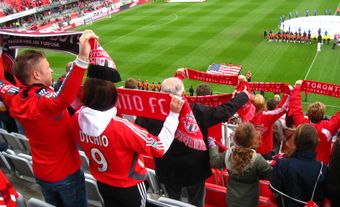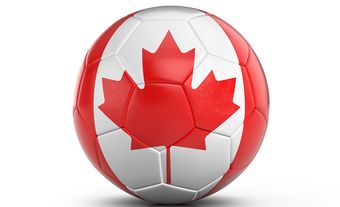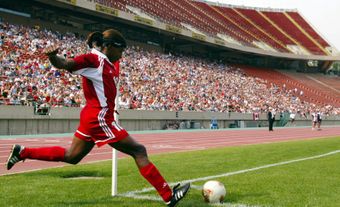
The State of Canadian Soccer in the 1980s
When qualifying began for the 1986 World Cup, Canada could boast a number of experienced and talented players. The Canadian men’s national team was fresh from a good showing in the 1984 Olympic Summer Games, which included a 3–1 victory over Cameroon before losing a penalty shootout to Brazil in the quarterfinals.
Most members of the national team had played in the North American Soccer League, and this experience showed. Captain Bruce Wilson had played for the Vancouver Whitecaps (1974–77), the Chicago Sting (1978–79) and the New York Cosmos (1980), where he had taken to the field with such stars as Giorgio Chinaglia, Johan Neeskens and Franz Beckenbauer. Wilson then played for the Toronto Blizzard (1981–84), but after the NASL suspended operations in the March of 1984, he — like fellow Canadians Randy Ragan, Pasquale De Luca, Trevor McCallum, Paul James, George Pakos, Ken Garraway, Paul Dolan, and Igor Vrbalic — was left with nowhere to play.
1985 CONCACAF Tournament and Qualification
Canada started its qualification campaign just weeks after the suspension of the NASL. Despite this turmoil, they breezed through the first stage of qualifying for the World Cup, defeating Haiti and Guatemala during the first round of the Confederation of North, Central American and Caribbean Association Football (CONCACAF) tournament. Only two CONCACAF countries would go to the World Cup, and since host Mexico was guaranteed a spot, it was critical that Canada win the tournament. In the final round, Canada, Honduras and Costa Rica played each other twice, once on home soil and once in an away game. Canada first hosted Costa Rica in Varsity Stadium, holding them to a 1-1 draw. The trip to Honduras was more successful, with George Pakos, who worked full-time for the City of Victoria as a meter-reader, scoring the only goal in a 1–0 victory. A 0–0 draw in San Jose, Costa Rica, put the Canadian team in pole position heading into the final game against Honduras.
The final game was played in mid-September in St. John’s, Newfoundland, in a temporary stadium set up at King George V Park. The crowd of 13,000 was fiercely pro-Canadian. In what is likely an apocryphal tale, a contingent of Honduran fans ended up in Saint John, New Brunswick, rather than its similarly named counterpart further east. An early goal from George Pakos gave Canada the lead, and although Honduras tied the score just after halftime, Igor Vrbalic scored in the 61st minute to pull Canada ahead. The team was jubilant.

Canada's 1986 World Cup Team
|
Number |
Name |
Position |
|
1 |
Tino Lettieri |
Goalkeeper |
|
2 |
Bob Lenarduzzi |
Defender |
|
3 |
Bruce Wilson |
Defender |
|
4 |
Randy Ragan |
Midfielder |
|
5 |
Terence Moore |
Defender |
|
6 |
Ian Bridge |
Defender |
|
7 |
Carl Valentine |
Forward |
|
8 |
Gerry Gray |
Midfielder |
|
9 |
Branko Segota |
Forward |
|
10 |
Igor Vrablic |
Forward |
|
11 |
Mike Sweeney |
Midfielder |
|
12 |
Randy Samuel |
Defender |
|
13 |
George Pakos |
Midfielder |
|
14 |
Dale Mitchell |
Forward |
|
15 |
Paul James |
Midfielder |
|
16 |
Gregory Ion |
Midfielder |
|
17 |
David Norman |
Midfielder |
|
18 |
James Lowery |
Midfielder |
|
19 |
Pasquale De Luca |
Midfielder |
|
20 |
Colin Miller |
Midfielder |
|
21 |
Sven Habermann |
Goalkeeper |
|
22 |
Paul Dolan |
Goalkeeper |
|
Tony Waiters |
Coach |
World Cup Preparations
However, the demise of the NASL left many on the Canadian team unemployed and scrambling for work. “Most of the players had no team,” head coach Tony Waiters later recalled. “So what we did was we formed more or less a team-in-being. And we’d go pretty well anywhere that would pay for us to come in and pay us when we got there. So we had a tour of North Africa. We went into Asia as well. Any opportunity to get a game where there’d be money coming in so we could turn some of that money around into players’ pockets.”
The Canadian Soccer Association also began a fundraising drive dubbed “March to Mexico,” producing a wide array of memorabilia, including a 7” record single entitled “(O Canada) We’ll Proudly Play For You,” written and performed by the Sons of Andrew, a duo from Edmonton, Alberta.
The team also spent significant time in the mountains of Colorado acclimatizing to the higher altitude. However, not all players had this luxury. Ian Bridge, for example, was held back by his club in Switzerland, while others plied their trade in the Major Indoor Soccer League. The team was also missing Dale Mitchell, who had been the top scorer in the early qualifying rounds before damaging his anterior cruciate ligament.
When Canada was put into Group C with Hungary, the Soviet Union and France, the reigning European champions, few were optimistic. “London bookies will give you 1,000–1 against the Canadians winning the Cup and 10-1 against them even scoring a goal,” wrote John Power of the Boston Globe. “Qualifying at all was a triumph; Canada's roster is filled with amateurs, indoor soccer players and NASL refugees. Goalie Tino Lettieri and an attacking defense led by Bruce Wilson should make them respectable, but logic says the Canadians don't advance.”
Holding Their Own Against France
Canada’s opening contest was against European champion France. The French team was built around Le Carré Magique (magic square) of Jean Tigana, Luis Fernández, Alain Giresse and Michel Platini, one of the best midfield collectives that world football has ever known. Canadian head coach Tony Waiters decided that sitting his players deep in their own end would play to their opponents’ strengths and instead instructed his team to press the French team relentlessly. After the game, the French head coach, Henri Michel, remarked that, "We knew the Canadians would run hard and try to make it difficult for us, but I was very surprised that they showed such aggression. They had moments to score. They played with honor. I admire them."
Goalkeeper Paul Dolan, starting in the World Cup at only 20 years old, had a commendable game, fending off the French for most of the match (he also had to ignore a live rooster that was tossed onto the field by French supporters in the second half). According to the FIFA official report, “The resolute tacklings of the Canadian athletes, their long passes from the solid defence, the swift moves on the wing, the sharp crosses and shots from all positions and distances… disconcerted the French time and again.” However, the French team finally made a breakthrough in the 79th minute. A long, flighted pass to the back post was misjudged by both Paul Dolan and Bobby Lenarduzzi. It was scuffed back into the six-yard box by Yannick Stopyra and headed into the net by Jean-Pierre Papin.
It was a heartbreaking loss, but Canada could take heart from the performance. Igor Vrbalic had a shot cleared off the line by a defender, and the defence was resolute in the face of what could have been an intimidating attack. Platini was typically gruff after the match, paying Canada a compliment of sorts when he said, “I was angry at our play, I'm getting old and I want to win the World Cup, but I was surprised also by the Canadians. They didn't let us play too well.”
Loss to Hungary
Canada’s second match was against Hungary, which had been thrashed 6–0 in its first match against the Soviet Union. The Canadians, on the other hand, were buoyant, despite their loss to France, and expected a good result. The Canadians were perhaps overconfident and conceded a goal in the second minute to Marton Esterhazy. Although Canada kept up their attack, they couldn’t put the ball in the net. Lajos Detari swept in a rebound in the 75th minute, which took the wind out of the Canadian sails and restored the confidence of the Hungarians.
Playing the Soviet Union
Beaten and bruised, there was almost no chance that Canada would proceed to the next round of the World Cup. Following a valiant defeat and an embarrassing capitulation, all that was left to play for was pride. That pride was, unfortunately, at stake against a solid and skilled side from the Soviet Union. Twelve of the squad came from the Dynamo Kyiv team that had just won the European Cup and were managed by the legendary Valeri Lobanovski.
Canada kept the score to 0–2 but was never really in the game. The official FIFA report, which had heretofore been rather complimentary about the Canadians, barely mentions their effort in the game against the USSR, simply stating that “Canada were a difficult opponent, displaying a great deal of determination, willpower and concentration. They also contributed to a good and fair atmosphere.” It did, however, go on to state that “Canada's brave performances in all their games should actually be a big additional motivation for the further improvement of football in this country.”
Legacy
For young players like Jason de Vos, who later captained the national team, the tournament served as inspiration. "Watching the Canadian players, most of whom I had never heard of, do battle against the Soviet Union, Hungary and the legendary French team was an experience that shaped my career. It motivated me to put in long hours of travelling and training, to forego the usual teenage life in favour of the more single-minded lifestyle of an athlete."
Since 1986, Canadians have played professionally overseas and in Major League Soccer (MLS), which includes three Canadian franchises. All three franchises have had success in domestic and continental competition, with both Montreal Impact and Toronto FC making it to the Final of the CONCACAF Champions League. Toronto FC holds the distinction of the record highest points total for the regular MLS season. There were also plans for a nationwide Canadian Premier League in 2019, with a focus on Canadian players and staff.

 Share on Facebook
Share on Facebook Share on X
Share on X Share by Email
Share by Email Share on Google Classroom
Share on Google Classroom






.jpg)
.jpg)
.jpg)